Today we’ll cover the best ways to store muffins, depending on the type of muffins you have.
Say you’ve baked or bought a whole bunch of muffins, and you’re wondering: how to store muffins so they stay fresh?
Or maybe your muffins regularly go stale after a day or two, or you always end up with a soggy base, and you’d like to fix that.
No worries, that’s what this article is all about. Let’s get right in.
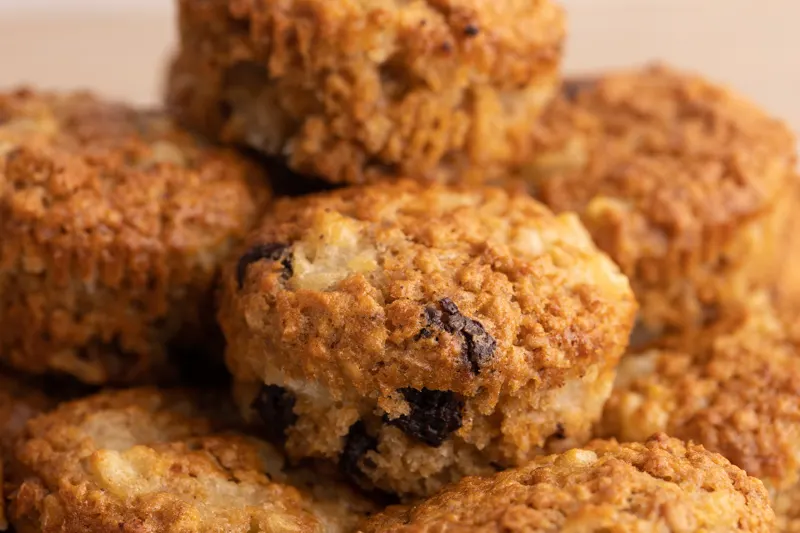
Table of Contents
- How to Store Muffins?
- Troubleshooting Soggy Muffins
- Should You Refrigerate Muffins?
- Can You Freeze Muffins?
- How Long Do Muffins Last?
- Muffins Storage Summary
How to Store Muffins?
You can store muffins on the counter or in the fridge. No matter which option you choose, make sure the muffins are sealed tightly, preferably in an airtight container. And place a paper towel underneath them to absorb excess moisture.
That’s the gist of it. Let’s get into the details.
For starters, you need to know that refrigerating muffins is okay, despite what some other websites say. And in some cases, it’s beneficial or even necessary.
I’ll explain when you should refrigerate muffins a bit later. But, for now, remember that storing muffins in the fridge isn’t inherently bad.
Let them cool
Before transferring your muffins to a container, you should allow them to cool.
Once you get the muffin pan out of the oven, let it sit on the counter for up to 5 minutes, then remove the muffins from the pan to continue cooling.
If possible, transfer the baked goods to a wire rack, which will allow them to cool fairly quickly. Alternately, any plate or cutting board will be okay too, but you’ll need a bit more cooling time for the same effect.
This phase should take anywhere between 30 minutes to maybe an hour, and the muffins should be at about room temperature, perfect for eating.
If your muffins are extra moist (think blueberry muffins or any other with lots of fresh fruit), consider leaving them uncovered for an extra hour or two. It’ll allow more moisture to escape, making them less likely to end up soggy the next day.
Muffins with cheese, meat, and fresh veggies should be refrigerated within two hours of baking. No need for prolonged cooling.

Seal in an airtight container
Line an airtight container with a paper towel, and transfer the muffins to the container. Then, if those are plain unfrosted muffins, place another paper towel on top of the baked goods.
Those paper towels are there to soak up any extra moisture that the muffins may release. This way, there are no water drops on the surface that may lead to mold, and the water that often ends up in the muffin base has a way to escape.
(More on troubleshooting soggy muffins in a moment.)
Check the paper towels daily, and replace them if they’re wet.
Next, don’t stack muffins in the container if possible. Plain muffins will probably retain their shape if stacked, but fruit-filled ones won’t necessarily do the same.
If your muffins are frosted, stacking is obviously out of the question.
Last but not least, using resealable bags to store muffins isn’t as bad as some say it is. As long as you wrap the muffins with paper towels, all excess moisture should be absorbed, and the baked goods shouldn’t end up soggy.
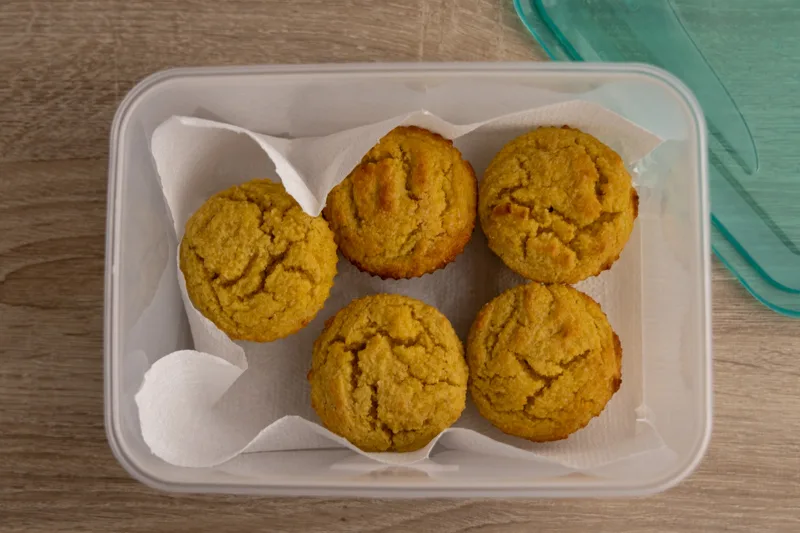
Troubleshooting Soggy Muffins
Soggy muffin bottoms is one of the issues many amateur bakers struggle with, and there are a couple of causes for why that happens, each with its own fix.
Let’s deal with them one by one.
Undercooked Muffins
If you undercook muffins, the top will be set and nicely lifted, but the center will still be quite wet.
To avoid that, make sure you cook your muffins thoroughly before you remove them from the oven. That might mean you have to bake them for two or three minutes more than the recipe suggests.
To check if everything is cooked, use a cake tester or a toothpick. Insert it in the center of a couple of muffins and check if it comes out clean each time.
That check is to ensure all the batter is cooked through, so it’s okay if the toothpick comes out with some chocolate or blueberries. Just make sure that’s not raw muffin batter.
(I know most recipes suggest this step, but I wanted to mention it anyway for the sake of completeness.)
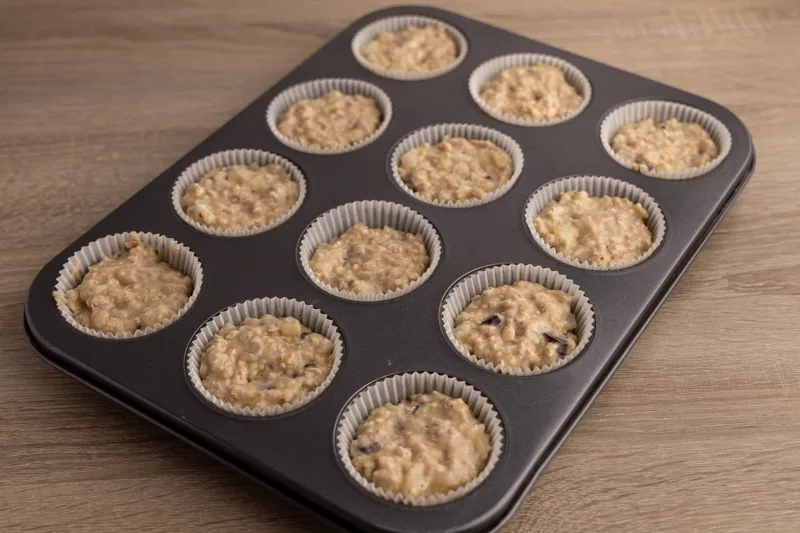
Too Short Cooling
The cooling phase is essential because it allows the muffins to release any excess steam built up inside. And if you seal muffins too soon, all that moisture will be trapped inside and most likely end up near the base. Thanks, gravity.
For proper cooling, remove the muffins from the tin after a few minutes of removing the muffin tin from the oven, and let them sit on a wire rack until they get to room temperature.
If they’re super moist, leave them uncovered for an extra one to two hours, letting more moisture escape.
No Paper Towels
If you don’t place a paper towel underneath the muffins, any excess moisture is trapped near the bottom of the muffin. Adding that towel and replacing it if it gets wet helps you get rid of that moisture.
Of course, plain muffins or ones with dry extras (think nuts, granola) don’t have that much moisture inside, and there won’t be much that those paper towels need to absorb. But for super moist blueberry muffins, the towels should help quite a bit.
Sunken Extras
If all the fruits, chocolate pieces, and what have you sink to the bottom instead of spreading evenly throughout the muffin, you will end up with a wet base no matter what. If all the wet stuff is there, small wonder the base is wet.
Fortunately, there’s an easy fix: tossing those ingredients in flour before folding them into the batter. That bit of flour helps suspend the goodies in place, preventing them (or at least slowing down) from gravitating towards the bottom.
For best results, add those coated ingredients to the batter right before filling the liners and placing the tin in the oven. We don’t want to give them time to sink, so make sure you preheat your oven and everything else is ready to go.
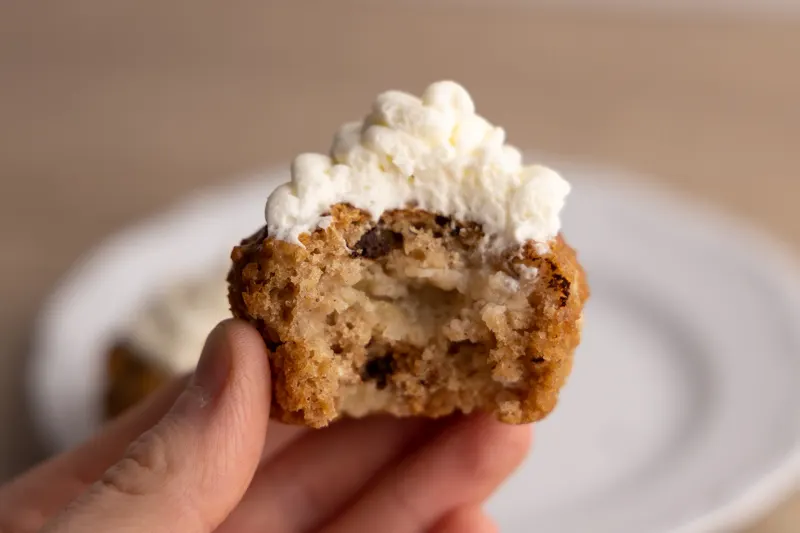
Should You Refrigerate Muffins?
Refrigerate muffins with a perishable frosting and all breakfast-style muffins with cheese, meat, or fresh veggies. Refrigeration is also a good idea if you need the muffins to last for more than a couple of days.
Regular plain muffins without any moist ingredients (think fruits) keep just fine on the counter for 3 to 4 days. But if you need them around for 5 to 7 days, you should refrigerate them.
That’s the short version. Next, let’s talk about the details and cases where it’s not clear whether you should store the muffins in the fridge or not.
(The rules below should also be helpful if you’re wondering how to store brownies or whether you should refrigerate cupcakes.)
Frosting and Filling
If you’re frosting your muffins with anything perishable, for instance, cream cheese frosting or anything else that’s dairy-based, those muffins need to sit in the fridge. The same is true if you’re filling them after baking with anything like jam.
Most frostings require refrigeration, so if you’re not sure if yours does or not, assume that it does. Better safe than sorry.
And even if it doesn’t need to sit in the fridge, ask yourself: will that frosting retain its shape (i.e., won’t melt) and quality if stored for a few days on the counter?
For most frostings, the answer is no. Buttercream is a good example here. Although it can sit at room temperature for a day or two, it stays fresh much longer when refrigerated.
Breakfast, Paleo, and Keto Muffins
Egg-based muffins with meat, cheese, or fresh veggies require refrigeration. You wouldn’t store cooked eggs, ham, and cheddar on the counter, and the same is true for this style of muffins.
Similar to the above are keto and paleo muffins, or any other muffins where regular flour is replaced with coconut or almond flour. Those muffins retain quality better if refrigerated, but it’s probably okay to keep them on the counter for 2 to 3 days.

Fresh Fruit
I recommend refrigerating muffins with fresh fruit after 1 to 2 days on the counter, or sooner. That’s because cut fruit, even baked, tends to grow mold quite quickly, often after a day or two at room temperature.
I know this is a bit of a gray area, so hear me out.
Most recipes suggest keeping muffins with fresh fruit on the counter for 4 to 5 days or refrigerating them if you need more time. And that suggestion works fine in most cases.
But the way I see it, it’s similar to storing apple pie. You leave it on the counter for a day or two or until you cut into it. Once cut, you refrigerate it.
Fruits in muffins are cut and baked, so I wouldn’t let them sit on a kitchen countertop for more than a day or so. For me, I refrigerate those muffins before the end of the day, meaning I don’t let them sit out overnight.
Of course, it also depends on how the fruit is incorporated.
Say you have banana muffins. If banana flesh is mashed and stirred into the batter to flavor it, those muffins should be fine at room temperature. But if banana pieces are spread throughout the batter, I’d consider refrigerating those muffins, especially if some end up exposed on the surface or you place them on top.
Use your better judgment on this one.
Can You Freeze Muffins?
Most muffins freeze well. The only exception is muffins that are frosted or filled, and that frosting or filling doesn’t withstand freezing well.
Plus, it’s typically better to freeze muffins and frosting separately so that you can beat the defrosted frosting for a few seconds before you frost your muffins.
When it comes to different types of muffins, plain muffins without any extras freeze best, and muffins with nuts and seeds are a close second. Muffins with fruits don’t freeze as well because they sometimes become soggy after defrosting, especially if they’re loaded with moist ingredients.
(Warming defrosted muffins in the oven for a couple of minutes before eating might help here. Just make sure you don’t burn the top or completely dry them.)
The freezing procedure is as easy as it gets: you place cold muffins in a ziplock bag, squeeze out excess air, and freeze them for 3 to 6 months.
Muffins don’t freeze together (unless they’re wet), so you can thaw as many as you need without worrying about the rest. Defrost them in the fridge overnight, and consider leaving them on the counter for 20 to 30 minutes before serving so that they warm up a bit.
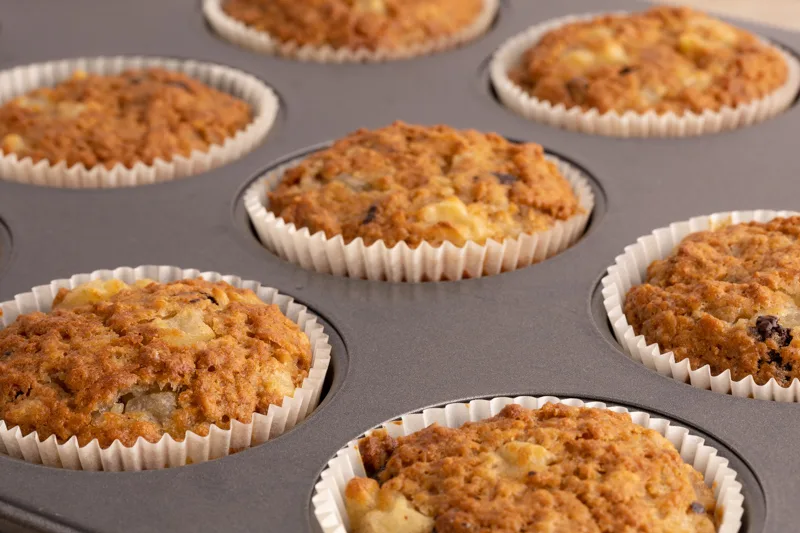
How Long Do Muffins Last?
| Counter | Fridge | |
|---|---|---|
| Plain muffins | 3-4 days | 1 week |
| Frosted-muffins | 4 days | |
| Pre-packaged muffins | Sell-by + 1-2 days | Sell-by + 1-2 days |
Muffins typically last for 3 to 4 days on the counter and up to a week in the fridge. That period shrinks to about four days for frosted or filled muffins.
If you’re baking breakfast-style muffins with cheese, ham, or fresh veggies, refrigerate them and finish within four days.
If those periods are not long enough, you can freeze muffins in most cases.
Of course, these storage times are only rough estimates, and if you’re baking muffins following a recipe, read the recipe notes for details on shelf life. If they’re absent, go with my suggestions.
For bakery-bought muffins, it’s best to ask the clerk about storage time. But if that’s not an option, go with 3 to 4 days of shelf life just to be safe.
Finally, if you’re buying pre-packaged muffins in the supermarket, those usually come with a sell-by date printed on the label. That date is a reasonable estimate of how long the baked goods should last, and typically all you can get is an extra day or two.
Muffins Storage Summary
Thanks for reading this primer on storing muffins. Here are the takeaways:
- You can store muffins at room temperature, in the fridge, or in the freezer, depending on the type of muffin you have and how long you need it to keep.
- Refrigerate muffins with cheese, ham, and fresh veggies, and consider refrigerating any muffins with coconut or almond flour. Storing muffins in the fridge is also a great option if you want them to last more than a couple of days.
- Once muffins cool after baking, place them in an airtight container lined with a paper towel. If you don’t frost them, add another paper towel on top to absorb any extra moisture.